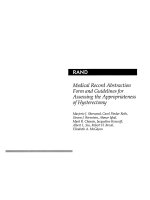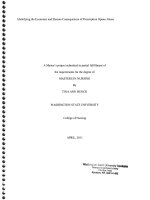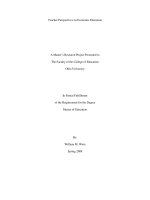Guidelines for Writing a Master’s Thesis pptx
Bạn đang xem bản rút gọn của tài liệu. Xem và tải ngay bản đầy đủ của tài liệu tại đây (41.07 KB, 7 trang )
Philipps-University – FB 02 – Macroeconomics – D-35032 Marburg
Faculty of Business Administration
and Economics
Macroeconomics
Professor Bernd Hayo
Tel.: +49 6421 28 23091
Fax: +49 6421 28 23088
E-Mail:
A
ddress: Universitaetsstrasse 24
35037 Marburg, Germany
Web: -
marburg.de/fb02/makro
Marburg, 6 June 2012
Guidelines for Writing a Master’s Thesis
I. Preparation for the Master’s Thesis
1. Choice of Topic
Topics can be chosen from all areas of Macroeconomics, Political Economy/Public Choice,
International Finance, European Integration, and Socio-Economics. Empirical research in
other fields is also welcome. If you are interested in writing your Master’s thesis in one of
these areas, please schedule an appointment with me, preferably during my office hours,
and bring along one or more ideas and, if possible, a rough outline of your planned study.
The Master’s thesis is ‘the crowning glory’ of your scientific education and should grow out of
a high degree of interest in a topic. Consequently, I expect that students should develop one
or more ideas about the research areas they are interested in and formulate a research
question. Only under exceptional circumstances, I am willing to assign a topic. After making
sure that your proposal is a suitable project for a Master’s thesis, the thesis topic can be
registered with the Examination Office.
2. Issuance of the Topic
Following the formalities of the curriculum, the chair of the Examination Board determines the
advisor, issues the topic on behalf of the advisor, and, as a general rule, chooses the second
advisor. In order to avoid delays with respect to the preferred starting date, the registration of
the thesis (the request for issuance of the topic) must take place at least 2 weeks prior to the
preferred starting date at the Examination Office.
2
3. Duration
For the MSc ‘Economics and Institutions’, the duration is scheduled to be 6 months, for the
MA ‘Economic Change in the Arab Region’ it is 4 months, for MA ‘Europa: Integration and
Globalisierung’ it is 14 weeks and for MA ‘International Development Studies’ it is 18 weeks.
Under special circumstances, the chair of the Examination Board may extend this period by a
maximum of 4 weeks. An (additional) extension due to illness, accident, disability, or special
family circumstances is generally possible.
4. Length of thesis
I do not consider it a great academic achievement to fill as many pages as possible in a
given time span. Or, as Goethe once said: ‘I do not have enough time to write a short letter,
therefore I send a long one.’ The maximum thesis length I find acceptable for a 6 months
thesis is 50 pages. In exceptional cases additional information may be put into an appendix
outside this page limit.
5. Language
For the MSc ‘Economics and Institutions’ and the MA ‘Economic Change in the Arab Region’,
the Master’s thesis must be written in English.
6. Submission
In general, the Master’s thesis must be submitted within the deadline in two bound versions
(paperback) and, additionally, as an electronic copy either as a CD-Rom, USB stick or email
attachment (pdf is fine, in case of an empirical thesis, please also include your data in a
spreadsheet format) to the Examination Office. In case that you are out of the country, it is
possible to submit an electronic copy only. Please make arrangements beforehand with the
examination office. MA ECAR students do not have to submit bound copies.
3
II. Basic Style and Formatting Rules
Title page of the Master Thesis
The title page of the Master thesis should contain the following information:
• Name of the examiner
• Thesis topic
• Name, address, email, and matriculation number of the author
• Name of the programme and number of semesters at the time of submission
Format of the Master Thesis
2.1 Line Spacing
Line spacing in the main text is 1.5; in footnotes and in figure and table sources single
spaced 1.0.
2.2 Font Type
Recommended font types are Arial, Calibri or Times New Roman. Font size should be 12pt
for Calibri and Times New Roman and 11pt for Arial in the main text, and 10pt respectively
9pt in footnotes as well as figure and table sources. Paragraphs must be justified.
2.3 Number of Pages / Length of the Thesis
Including the bibliography as well as figures and tables, the Master thesis should not be
longer than 50 pages. The title page, the table of contents, and, if applicable, the lists of
abbreviations, tables, figures, and symbols do not count.
2.4 Page Format
The margin is formatted as follows:
• Left margin: 2.5 cm
• Right margin: 2.5 cm
• Top margin: 2.5 cm
• Bottom margin: 2.0 cm
Pages have to be numbered consecutively.
2.5 Structure: Chapters and Subchapters
The main text must have a decadal structure (e.g. 1., 1.1, etc.). Single subchapters, for
example using 1.1 without 1.2, are not appropriate.
4
2.6 Index of Figures, Tables etc.
The thesis must be accompanied by a table of contents. If your thesis contains figures and
tables, an index of figures and tables, in order of their appearance, should be included. If
necessary, a list of abbreviations (all abbreviations used in the text and in the bibliography)
should also be included. All indexes and lists include the pages where the respective figures
etc. appear in the text. In addition, a table of symbols (list of all used symbols such as Y =
GDP etc.) might be necessary. Pages containing indexes and lists must be numbered with
roman numbers (I,II,III). A mathematical annex is numbered with Arabian numbers (1,2,3).
The bibliography is the concluding part of the Master thesis.
2.7 Equations
Equations are to be numbered consecutively, e.g.:
MPL = F(K,L+1)-F(K,L) (1)
2.8 Figures and Tables
Figures and tables have to be numbered consecutively and must be assigned a title and a
source, e.g.:
Above the figure: Figure. 2: Development of Indicators for indebtedness.
Below the figure: Source: World Bank (1999, 9), with the source specified in the list of
references.
2.9 Footnotes
As a general rule, footnotes should be placed on the same page as the respective text they
belong to. They have to be numbered consecutively.
2.9.1 Quotations in the Main Text
Whenever you directly or indirectly quote sources from literature, these references must be
indicated right in the text and right after the quote in short form by using the following
scheme: (last name of author and year of publication, exact page(s)).
Example for an indirect quote:
At least in the case of the UK and the US, estimated money demand functions became increasingly
instable from the early 1970s onwards (Howells and Bain 2008, 270).
The indication of the exact source must be repeated each time, within reasonable limits,
when the respective source is used. Direct quotes must be additionally marked by employing
quotation marks (inverted commas).
Example for a direct quote:
‘However, in the early 1970s the demand for money function began to show signs of instability in both
the UK and the USA’ (Howells and Bain 2008, 270).
5
2.9.2 List of References
In the list of references, all references used in the writing of the thesis must be listed in
alphabetical order of the authors’ last name. This includes books and related publications,
contributions to collective volumes, articles in scientific and non-scientific journals and
newspapers as well as dissertations and Master’s theses. Sources from the internet must be
accompanied by the exact link and the date of download.
There are many different possible citation formats. You are free to choose your preferred
style. The chosen citation style must be consistent throughout the entire document. The
following example can be used as a reference for one possible citation format.
For books and independent publications, e.g.:
Copeland, L. (2008). Exchange Rates and International Finance, 5. ed., Harlow: Pearson.
For articles/contributions to collective volumes, e.g.:
Levich, R.M. (1985). Empirical Studies of Exchange Rates: Price Behavior, Rate Determination and
Market Efficiency, in: R.W. Jones and P.B. Kenen (eds.), Handbook of International Economics, Vol. II,
International Monetary Economics and Finance, North-Holland: Amsterdam, 979-1040.
For journals articles, e.g.:
Rogoff, K. (1996). The Purchasing Power Parity Puzzle, Journal of Economic Literature 34,
647-688.
For unpublished work, e.g.:
Mustermann, J. (1999). Reforming the international monetary system, mimeo, Philipps-
Universität: Marburg.
Additional Hints:
• If there are more than three authors, in the main text just list the first author and add ‘et
al’, e.g. Jones et al. (1999). The bibliography must contain the full names of all authors.
• If there is no apparent author, the reference starts with naming the organisation (EBRD)
that published the document or with naming the source (The Economist).
• If more than one source of the same author is cited, all cited sources are to be sorted
according to their year of publication. The oldest work will be listed first. If two or more
sources are by the same author and of the same year, add small letters to the publication
year to distinguish between the sources, e.g., Frey, B. (1990a), Frey, B. (1990b), etc.
6
• More useful hints can be found, for instance, in Booth, W.C., Williams, J.M., and
Colomb, G.G. (1995): The Craft of Research (Chicago Guides to Writing, Editing, &
Publishing), 1
st
ed., University of Chicago Press.
• Bailey, Stephen (2006): Academic Writing: A Handbook for International Students, 2
nd
ed., Taylor & Francis.
III. Some Advice for your Literature Research and Data Collection
In the preparation of a Master’s thesis, it is helpful to make use of the ‘Journal of Economic
Literature’ to search for relevant sources. JEL is a journal that systematically catalogues
articles from relevant international economics journals. This data base is available under the
name ‘ECONLIT’ in the online sources of the faculty library (see its webpage). In addition,
there are other online data bases with respect to economic and socio-economic literature
(WISO, SSCI). Another source for literature research is ECONIS, the online data base of the
Central Library for Business and Economics of the Kiel Institute for World Economy. ECONIS
is available online at:
. Current and past discussion papers can
be downloaded from EconPapers at
and SSRN www.ssrn.com.
Macroeconomic and financial data on most countries in the world (from IMF, World Bank,
EU, etc) are available from the commercial online data base ‘Statistiknetz.de’ that can be
accessed freely via the faculty library. Access requires a university IP, so you must use a
university computer or install the VPN client and log in using your HRZ name and password.
IV. Scientific Integrity
An important basic of scientific research is a thorough and honest recognition of other
people’s work. Due to the easy availability of information through the library and in particular
the internet, there is a temptation to use ideas of other authors and present them as one’s
own. It is therefore important to consistently cite your sources. Otherwise, I have to assume a
deliberate attempt of deception and will ruthlessly fail your thesis. Moreover, the submission
of a Master’s thesis written by a third person or institution under your name is also
considered to be an attempt of deception and will be assigned the corresponding grade.
Together with the Master’s thesis, a declaration of authorship (in German) has to be put at
the end of your paper and signed by you. Stick exactly to the following example (word-by-
word). Please be sure that you have fully understood the declaration before you sign it. It
says the following: By signing, you declare that you wrote the thesis on your own and listed
the relevant sources that you used. Furthermore, you indicate that you correctly named all
parts of the thesis where you made use of ideas and thoughts of others including those
obtained from the internet. You also acknowledge that by violating these conditions, you will
fail the thesis.
7
Declaration of Authorship
„Ich versichere durch eigenhändige Unterschrift, dass ich die Arbeit selbstständig und ohne
Benutzung anderer als der angegebenen Hilfsmittel angefertigt habe. Alle Stellen, die
wörtlich oder sinngemäß aus Veröffentlichungen (auch aus dem Internet) entnommen sind,
habe ich als solche kenntlich gemacht. Ich weiß, dass bei Abgabe einer falschen
Versicherung die Arbeit als mit 'nicht ausreichend' (1 Bewertungspunkt gemäß § 16 Abs. 2
Allgemeine Bestimmungen, Note 5, ECTS-Grade F) bewertet gilt.“









